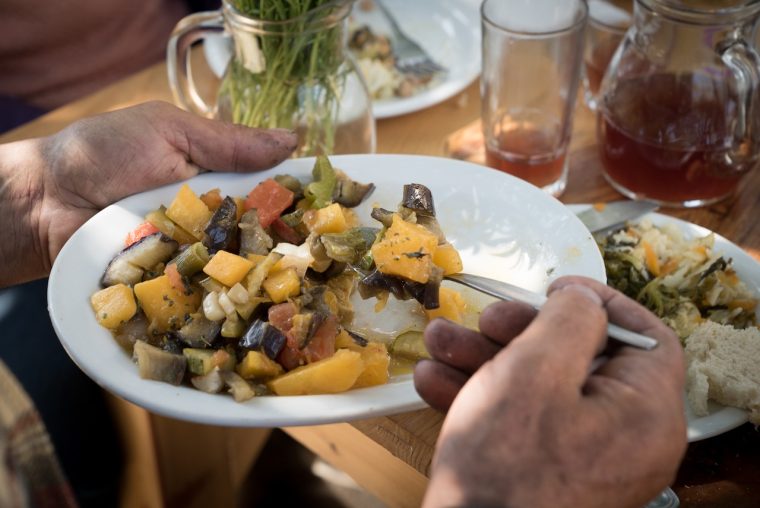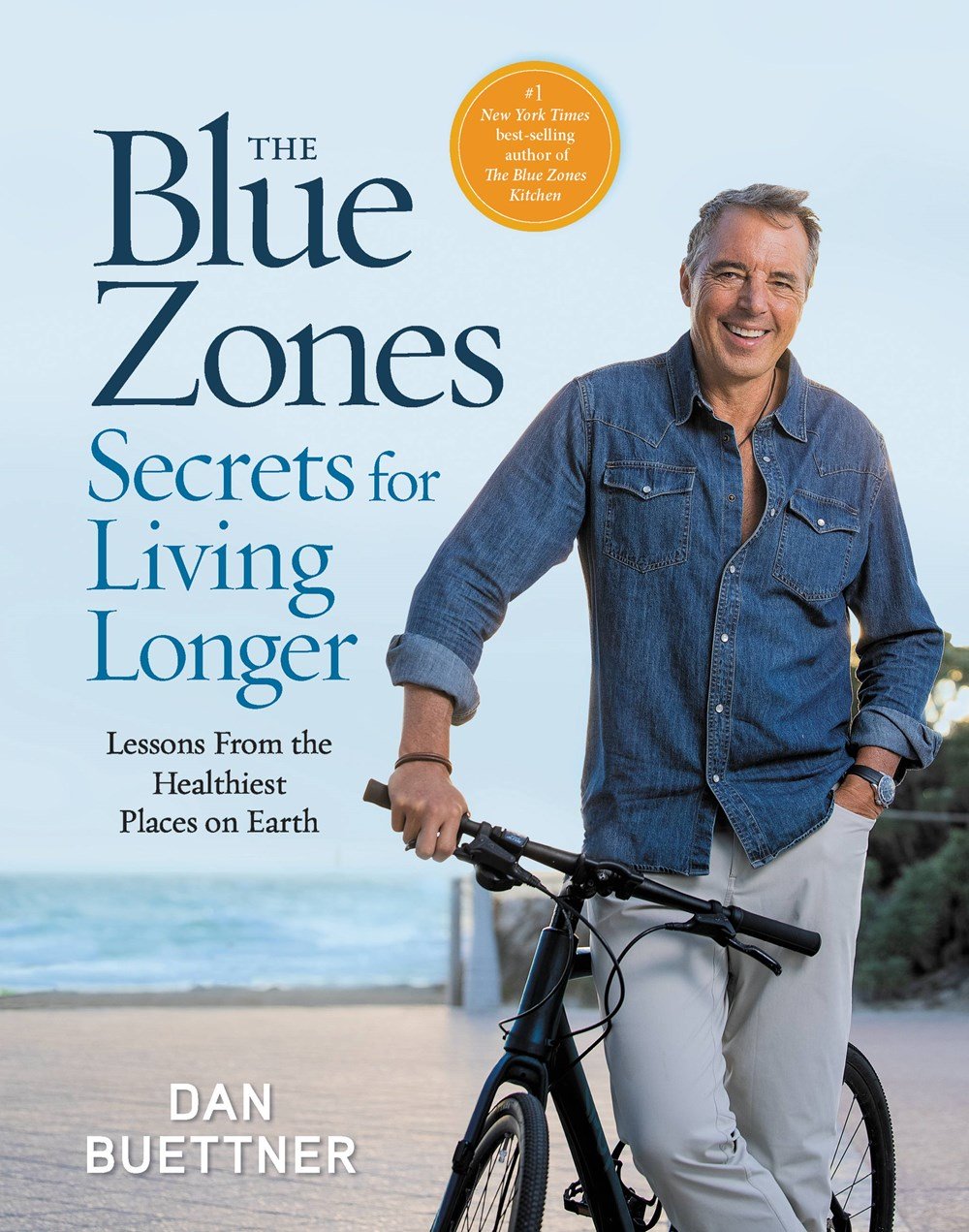I want to start today’s edition of Eating to 100 by quoting the legendary John Wooden. For those of you who don’t know, he was a basketball coach for UCLA, and you don’t need to know anything about basketball to appreciate something he often told his players:

Sage as it is, I hesitate to repeat this advice in 2023 because I don’t want to encourage more speed when so much of my work is about the importance of slowing down. But I still decided to mention it because Mr. Wooden’s distinction between quickness and hurry is important to today’s discussion.
Quickness means that you’re doing things directly and without delay, whereas hurry means that you’re scrambling to make every last effort at the last possible second. On the outside, they often look pretty similar—but they feel radically different on the inside, because quickness is about focus and hurry is about desperation.
Wooden repeated this mantra to his players because it kept their minds sharp in all the right ways. A player with a quiet mind, who is quick but not hurried, is likelier to make the shots they take, and—just as important—they’re less likely to make rash, costly mistakes like fouls.
Here’s where me and Eating to 100 come in…
There’s nothing wrong with wanting foods to be ready quickly. If you’re busy and you’re hungry and it’s mealtime, I totally get it. But when we hurry the process—for example, when we can’t spare 10 minutes to cook some proper oatmeal and instead demand that it be ready in 90 seconds—there are nutritional costs whose consequences we can actually feel (like higher glycemic index, which causes a blood-sugar spike).
You can’t have it both ways. There are tradeoffs to everything. And while longevity-friendly foods don’t take especially long to prepare (a lot of them are simple), the nature of working with clean whole ingredients is that they don’t have any pre-processed shortcuts built in. They take however long they take—and thinking this way can take a little bit of adjustment when you’re used to having certain things available in a hurry.
Speaking of quickness and hurry, the other big topic for today is… fasting!
That’s a bad pun. As you probably know, fasting means something totally different in a dietary context; it means “not eating” rather than “speeding.” Still, in Wooden’s spirit, we can make some quick starting judgments about fasting without jumping to hurried judgments about it.

I’m just gonna come right out and say it: there’s no way to introduce oatmeal in a way that makes it sound fresh and alluring and new. I could try, but you would feel duped the moment you realize I’m hyping freaking oatmeal, one of the least sexy foods on the planet both in name and appearance.

I love oatmeal and I’ll tell you why, but… yeah. I think this article from the American Heart Association nailed it with its opening salvo:
Let’s admit it: Oatmeal is a total nerd. It lacks fashion sense – the color they named after it is somewhere on the drab side of beige. It’s often seen with Sesame Street’s Bert, who also loves bottle caps, paper clips and pigeons. But when it comes to healthy eating, oatmeal and the oats it comes from can definitely hang with the cool kids at the breakfast table.
The two main appeals of oatmeal are simple: it can be really good for you, and it can also be really delicious in a way that’s customized to your tastes. In other words, it’s actually a really amazing breakfast when you take the time to do it the right way (more on that in a bit).
I do firmly believe that oatmeal is the kind of food everybody can like once they’ve had it prepared the right way, and (for better and worse) there are a thousand different ways you can prepare it. Stick with me and you might find the blue-zone breakfast you didn’t even know you would love!
Five easy pieces, starting from the beginning…
What is oatmeal, really?
Before we even get to oatmeal, we have oats—a cereal grain (basically an edible grass) like barley and wheat. Oatmeal just refers to oats that have been processed to remove the inedible husk, then mostly either (A) cut into chunky pieces or (B) steamed and then rolled flat into flakes.
Oatmeal, in other words, is just oats that have been processed enough to be easily cooked and eaten by humans. Per the above, there’s no single form of oatmeal; you can find multiple varieties at the store, and I’ll talk more about that over the next two questions.
What makes REAL oatmeal so good for you?
I explain what I mean by “real oatmeal” in the next question, but to rattle off a few of its health benefits:
- Oats are loaded with nutrients, especially vitamins and minerals—and because they’re relatively low in calories, they’re considered nutrient-dense.
- Oats have a ton of fiber—specifically a soluble fiber called beta-glucan which helps you to feel full for longer AND which helps undigested food make it further down your digestive tract to feed the microbiota deep in your gut. (Soluble fiber is fiber that dissolves in hot water; beta-glucan is what gives oatmeal its vaguely slimy shimmer.)
- Oatmeal has a low glycemic index, meaning that it helps to moderate the rising and falling of blood-sugar levels (no spikes or crashes). And speaking of moderating things in your blood…
- Oats are proven to help maintain healthy blood cholesterol levels, so much so that they became the first food with an FDA health-claim label in 1997.
Why do you emphasize “REAL” oatmeal (and what is that)?
What I call Real Oatmeal is basically just any version of oatmeal that is NOT Quick/Instant Oatmeal.
You see, quick oats are a bit of a Faustian bargain. You do get what you came for (oatmeal in 1-2 minutes rather than 10), but what it costs you isn’t really worth it in the grand scheme of things, and most people don’t realize that until it’s too late.
A chemist’s usual trick for speeding up cook times is to increase the surface area of the reactants, usually by processing them into smaller and smaller pieces. In the case of oats, that’s usually done by steaming and rolling the oats into thinner and thinner flakes. But the tradeoff cuts both ways: the same thing that makes them quicker to cook also makes them quicker to digest, which robs you of a lot of the nutritional benefits (particularly where glycemic index is concerned).
In other words: a lot of instant-oatmeal eaters experience regular sugar crashes because they didn’t take eight more minutes to make the real thing. And that’s a shame, albeit a solvable one.
How can I mix up oatmeal to make it my own?
Without even touching the different varieties of old-school oats you can buy (I like steel-cut), I can think of five different categories of things you might add to oatmeal to make it a breakfast you’d want to eat.
Not all of these ideas are equally nutritious, of course, but there’s a huge range of possibilities here (and if you’re new to oatmeal, feel free to err on the side of decadence until you develop a general taste for it).
- Nuts like almonds and walnuts. I usually prefer slivered, but texture is a matter of personal taste as well.
- Creamers like soy milk. I encourage you to experiment with plant-based alternatives here—not just for their health benefits over regular dairy, but because they add different “twists” without overwhelming the general flavor.
- Spices like cinnamon and cardamom. Really, whip out any of your favorite baking spices and they have a chance of enhancing your oatmeal.
- Sweeteners like maple syrup, honey, or brown sugar. I hope you’ll avoid plain white sugar here for the simple reason that it’s not as interesting… if you must add sugar, add a version with some flavor!
- Fruit like dates, fresh berries, sliced bananas, or cubed Granny Smith apples. Depends on your taste and the other ingredients chosen from above.
What can I learn from this even if I don’t like oatmeal (and never will)?
To me, oatmeal is a great example of the way that our relationship with time has distorted our relationship with nutrition.
My educated guess is that most of America’s oatmeal eaters are eating the quick and instant varieties—and maybe we know that there’s an old-school way of doing it, but we don’t see the point. We think: why spend 10 minutes in front of the stove when the microwave could do it in a fraction of the time?
That’s a perfectly logical thought, but only if you accept its unspoken assumptions: that the quicker solution is always better, that you should save every minute you possibly can, and (most telling of all) that your breakfast is less important than the time you’re saving.
Um, excuse me. Since when is TEN MINUTES too much time to spend on the most important meal of the day? In reality, it’s some of the healthiest time we can possibly spend on a daily basis. It sets us up for success in all of the hours that follow—hours in which so many of the people who saved eight paltry minutes lose far more than that to brain fog.
So whether you’re an oatmeal eater or not, oatmeal is a good example of the way we need to recalibrate our priorities. Like a lot of healthy, wholesome eating, real oatmeal isn’t hard or “tricky” or particularly time-consuming… but it takes the time it takes, and that thought can require some readjustment in today’s shortcut-loving world.

People living in blue zones aren’t actively trying to cultivate habits for long life. Their environments are set up in ways that naturally support healthy behaviors. In this section of Eating to 100, I will share one simple habit you can incorporate into your life. Do it long enough, it becomes part of how you live. Build up enough of these habits, you’ll likely add years to your life and life to your years.
Fasting is a scary word, or at least a dramatic one. It calls to mind hunger strikes, Biblical penance, and (not least of all) the kind of gnawing hunger that can make anyone miserable.
It’s easy to get the sense that fasting is contrary to our survival instincts, that it’s bound to feel like punishment, and (at certain times) that the only people who are enthusiastic about fasting are the ones who make sure you hear it.
But today, I want to talk about everyday fasting for regular people. I want to demystify fasting a little bit. So first, I’ll tell you what it is and why it’s useful, and then I’ll tell you about a couple of simple, starter fasting practices that you can try for yourself.
First things first: fasting is just “not eating,” plain and simple. By definition, you’re fasting during any period of time when you’re not eating. Some people will follow specific fasting regimens, but the key thing to understand here is that everybody fasts whether they realize it or not.
In this spirit, the true meaning of “breakfast” has been hiding right in front of your face this whole time. Breakfast is the meal that breaks your nightly fast, and it’s a reliable name because you’re necessarily fasting whenever you sleep.
So the What of fasting is relatively simple. Now let’s talk about the Why.
The central reason that fasting is important (whether you practice it deliberately or not) is, in a phrase, circadian rhythm. In plain English: your gut needs rest the same way your brain and muscles do. In fact, as I’ll discuss further down, your gut actually needs a longer period of rest (from solid food) than the eight hours your brain needs for a good night’s sleep!
The healthiest people tend to eat in a way that syncs up with circadian rhythm; they eat their biggest meals when the gut is most active, and they lay off the snacks when the gut is winding down for the day. By resting the gut fully, it’s primed and ready for maximum power extraction the following day.
Finally, we come to the How. Before I share my three quick suggestions, just bear in mind that this is barely scratching the surface, and we can return to the topic of fasting in later editions…
- Practice Time-Restricted Eating (TRE). Ideally, you would allow your gut a 13-hour break between your last bite of food at night and your first bite of food the following morning (consuming only water in that 13-hour period). As you’ll see by playing with that math, midnight snacking is discouraged.
- Mind your schedule and surroundings. This means, first of all, that you should take a moment to make yourself aware of strategically-placed snacks that make it easy for you to break TRE without totally thinking about it. But more abstractly, it means that fasting doesn’t happen in a vacuum; you have to think a bit bigger-picture about how regimens (even simple ones like TRE) will work in daily life. Small example: a habit of staying up late makes fasting and TRE harder.
- Assume that fasting is about delaying food, not denying it. Even if your diet doesn’t change one lick, you can do your gut a ton of good just by giving it more opportunities for consistent rest—especially if you’re the night-owl, midnight-snacking type who’s been habitually cutting that rest short.

Oatmeal Breakfast Cookies

Ingredients
3 large ripe bananas
1 3⁄4 cups quick oats
1⁄4 cup chocolate chips
1⁄4 cup applesauce
Honey (optional)
Crushed nuts (optional)
The Method
- Preheat oven to 350 degrees. Line a baking sheet with parchment paper or grease with cooking spray.
- Mash bananas in a bowl; add oats and mix well to combine.
- Fold in chocolate chips and applesauce.
- Use a tablespoon to measure out portions of the dough, dropping onto the baking sheet. You can shape these into balls or press and flatten each cookie with a spoon. (It will not spread out much during baking.)
- Bake for about 15 minutes or until cookies are lightly browned on top. Remove and let cool on a rack.
- Roll in honey and then crushed nuts, if using, when cool enough to handle.





